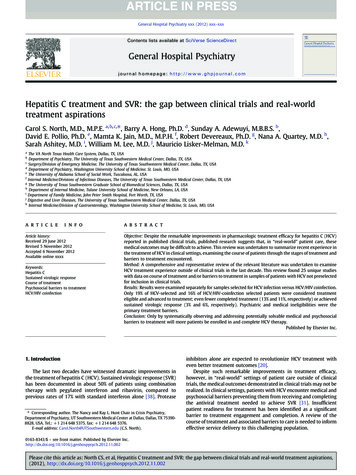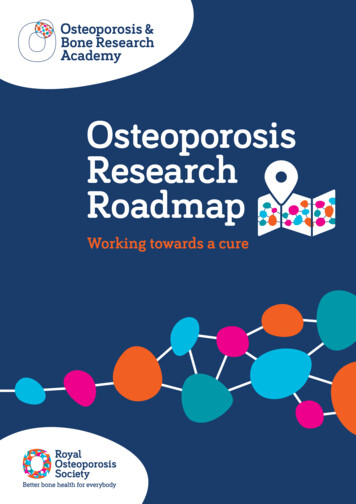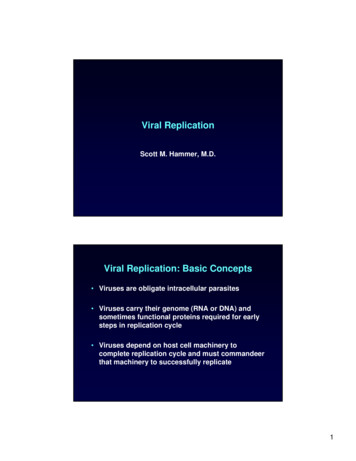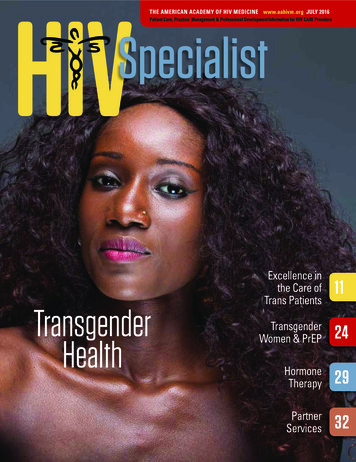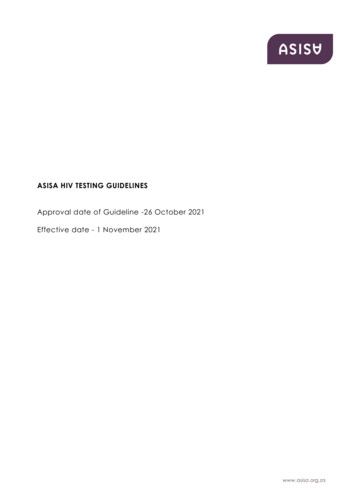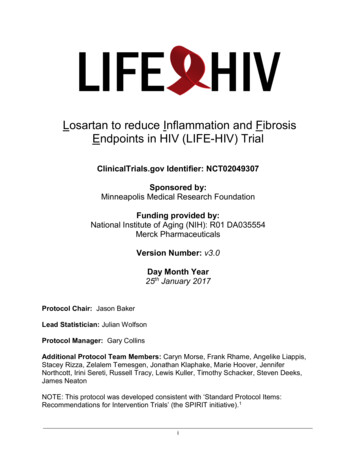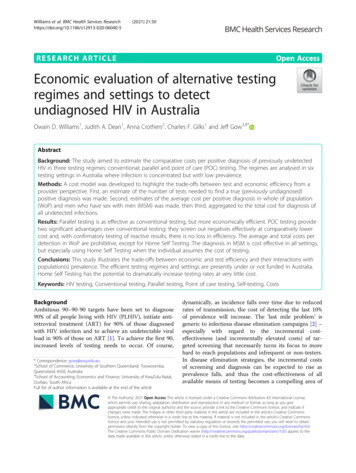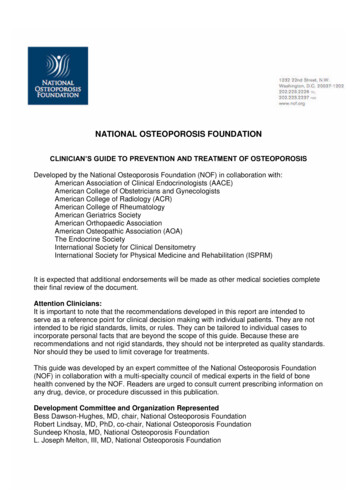
Transcription
NATIONAL OSTEOPOROSIS FOUNDATIONCLINICIAN’SGUIDETO PREVENTIONANDTREATMENTOF OSTEOPOROSISDeveloped by the National Osteoporosis Foundation (NOF) in collaboration with:American Association of Clinical Endocrinologists (AACE)American College of Obstetricians and GynecologistsAmerican College of Radiology (ACR)American College of RheumatologyAmerican Geriatrics SocietyAmerican Orthopaedic AssociationAmerican Osteopathic Association (AOA)The Endocrine SocietyInternational Society for Clinical DensitometryInternational Society for Physical Medicine and Rehabilitation (ISPRM)It is expected that additional endorsements will be made as other medical societies completetheir final review of the document.Attention Clinicians:It is important to note that the recommendations developed in this report are intended toserve as a reference point for clinical decision making with individual patients. They are notintended to be rigid standards, limits, or rules. They can be tailored to individual cases toincorporate personal facts that are beyond the scope of this guide. Because these arerecommendations and not rigid standards, they should not be interpreted as quality standards.Nor should they be used to limit coverage for treatments.This guide was developed by an expert committee of the National Osteoporosis Foundation(NOF) in collaboration with a multi-specialty council of medical experts in the field of bonehealth convened by the NOF. Readers are urged to consult current prescribing information onany drug, device, or procedure discussed in this publication.Development Committee and Organization RepresentedBess Dawson-Hughes, MD, chair, National Osteoporosis FoundationRobert Lindsay, MD, PhD, co-chair, National Osteoporosis FoundationSundeep Khosla, MD, National Osteoporosis FoundationL. Joseph Melton, III, MD, National Osteoporosis Foundation
Anna N.A. Tosteson, ScD, National Osteoporosis FoundationMurray Favus, MD, American Society for Bone and Mineral ResearchSanford Baim, MD, International Society for Clinical DensitometryInterspecialty Medical Council ReviewersWilliam C. Andrews, MD, American College of Obstetricians and GynecologistsCarolyn Beth Becker, MD, The Endocrine SocietyChad Deal, MD, American College of RheumatologyWendi El-Amin, MD, National Medical AssociationF. Michael Gloth, III, MD, American College of PhysiciansMartin Grabois, MD, American Academy of Pain ManagementPatricia Graham, MD, American Academy of Physical Medicine and RehabilitationCol. Richard W. Kruse, DO, MD, American Academy of PediatricsE. Michael Lewiecki, MD, International Society for Clinical DensitometryKenneth W. Lyles, MD, American Geriatrics SocietyJohn L. Melvin, MD, International Society for Physical Medicine and Pain RehabilitationSteven Petak, MD, JD, American Association of Clinical EndocrinologistsHelena W. Rodbard, MD, American Medical AssociationStuart Silverman, MD, American Society for Bone and Mineral ResearchRonald Bernard Staron, MD, American College of RadiologyKedrin Van Steenwyk, DO, American Osteopathic AssociationAndrew D. Bunta, MD, American Orthopaedic AssociationLaura L. Tosi, MD, American Academy of Orthopaedic SurgeonsDisclosureNo member of the Guide Development Committee has a relevant financial relationship withany commercial interest.Note to ReadersThis revised guide is designed to serve as a basic reference on the prevention, diagnosis,and treatment of osteoporosis in the USA. It is based largely on the World HealthOrganization (WHO) 10-year fracture risk model and an accompanying economic analysisprepared by the National Osteoporosis Foundation (NOF) in collaboration with the WHO (Dr.J. Kanis), the American Society of Bone and Mineral Research, the International Society forClinical Densitometry, and a broad multidisciplinary coalition of clinical experts. The purposeof the revision is to encourage more appropriate testing and treatment of those at risk offractures attributable to osteoporosis.This guide is intended for use by clinicians as a tool for clinical decision making in thetreatment of individual patients. While the guidance for testing and risk evaluation comesfrom an analysis of available epidemiological and economic data, the treatment information inthis guide is based mainly on evidence from randomized, controlled clinical trials. Theefficacy (fracture risk reduction) of medications was used in the analysis to help definerecommended levels of risk for intervention.The guide addresses postmenopausal women and men age 50 and older. The guide alsoaddresses secondary causes of osteoporosis which should be excluded by clinical evaluation. National Osteoporosis Foundation, 20082
Furthermore, all individuals should follow the universal recommendations for osteoporosisprevention outlined in this guide.The recommendations herein reflect an awareness of the cost and effectiveness of bothdiagnostic and treatment modalities. Some effective therapeutic options that would beprohibitively expensive on a population basis might remain a valid choice in individual casesunder certain circumstances. This guide cannot and should not be used to govern healthpolicy decisions about reimbursement or availability of services. Its recommendations are notintended as rigid standards of practice. Clinicians should tailor their recommendations and, inconsultation with their patients, devise individualized plans for osteoporosis prevention andtreatment.TABLE OF CONTENTSOSTEOPOROSIS: IMPACT AND OVERVIEWExecutive SummarySynopsis of Major Recommendations to the ClinicianScope of the ProblemMedical ImpactEconomic TollBASIC PATHOPHYSIOLOGYAPPROACH TO THE DIAGNOSIS AND TREATMENT OF OSTEOPOROSISRisk AssessmentClinical EvaluationDiagnosisBMD Measurement and ClassificationWho Should Be Tested?Additional Skeletal Health Assessment TechniquesUse of World Health Organization Fracture Risk AlgorithmUNIVERSAL RECOMMENDATIONS FOR ALL PATIENTSAdequate Intake of Calcium and Vitamin DRegular Weight-Bearing ExerciseFall PreventionAvoidance of Tobacco Use and Alcohol AbusePHARMACOLOGIC THERAPYWho Should Be Treated?US FDA-Approved Drugs for Osteoporosis National Osteoporosis Foundation, 20083
BisphosphonatesCalcitoninEstrogen/Hormone TherapyEstrogen Agonist/AntagonistParathyroid HormoneMonitoring Effectiveness of TreatmentBone Mineral DensityBiochemical MarkersPHYSICAL MEDICINE AND REHABILITATIONCONCLUSIONS AND REMAINING QUESTIONSGLOSSARYKEY REFERENCESOSTEOPOROSIS: IMPACT AND OVERVIEWExecutive SummaryOsteoporosis is a silent disease until it is complicated by fractures - fractures that can occurfollowing minimal trauma. These fractures are common and place an enormous medical andpersonal burden on aging individuals and a major economic toll on the nation. Osteoporosiscan be prevented and can be diagnosed and treated before any fracture occurs. Importantly,even after the first fracture has occurred, there are effective treatments to decrease the riskof further fractures. Prevention, detection, and treatment of osteoporosis should be amandate of primary care providers. This updated guide offers concise recommendationsregarding prevention, risk assessment, diagnosis and treatment of osteoporosis inpostmenopausal women and men age 50 and older. It includes indications for bonedensitometry and fracture risk thresholds for intervention with pharmacologic agents. Sincethe NOF first published the guide in 1999, it has become increasingly clear that manypatients are not being given appropriate information about prevention; many patients are nothaving appropriate testing to diagnose osteoporosis or establish osteoporosis risk; and, oncediagnosed (by testing or by the occurrence of a fracture), too many patients are not beingprescribed any of the FDA-approved, effective therapies.Synopsis of Major Recommendations to the ClinicianFor postmenopausal women and men age 50 and older:1. Counsel on the risk of osteoporosis and related fractures.2. Check for secondary causes.3. Advise on adequate amounts of calcium (at least 1200 mg/d, including supplements ifnecessary) and vitamin D (800 to 1000 IU per day of vitamin D3 for individuals at risk ofinsufficiency). National Osteoporosis Foundation, 20084
4. Recommend regular weight-bearing and muscle-strengthening exercise to reduce the riskof falls and fractures.5. Advise avoidance of tobacco smoking and excessive alcohol intake.6. In women age 65 and older and men age 70 and older, recommend BMD testing.7. In postmenopausal women and men age 50-70, recommend BMD testing when you haveconcern based on their risk factor profile.8. Recommend BMD testing to those who have suffered a fracture, to determine degree ofdisease severity.9. Initiate treatment in those with hip or vertebral (clinical or morphometric) fractures.10. Initiate therapy in those with BMD T-scores -2.5 at the femoral neck, total hip, or spineby DXA, after appropriate evaluation.11. Initiate treatment in postmenopausal women and in men age 50 and older with low bonemass (T-score -1 to -2.5, osteopenia) at the femoral neck, total hip, or spine and 10-yearhip fracture probability 3% or a 10-yr all major osteoporosis-related fracture probabilityof 20% based on the US-adapted WHO absolute fracture risk model.12. Current FDA-approved pharmacologic options for osteoporosis prevention and/ortreatment are bisphosphonates (alendronate, ibandronate, risedronate, and zoledronate),calcitonin, estrogens and/or hormone therapy, raloxifene and parathyroid hormone (PTH1-34).13. BMD testing performed in DXA centers using accepted quality assurance measures isappropriate for monitoring bone loss (recommendation every 2 years). For patients onpharmacotherapy, it is typically performed two years after initiating therapy and at 2-yearintervals thereafter.Scope of the ProblemOsteoporosis is the most common bone disease in humans and represents a major publichealthproblem handOsteoporosis (1). It is characterized by low bone mass, deterioration of bone tissue anddisruption of bone architecture, compromised bone strength, and an increase in the risk offracture. According to the World Health Organization (WHO) diagnostic classification,osteoporosis is defined by bone mineral density (BMD) at the hip or spine that is less than orequal to 2.5 standard deviations below the young normal mean reference population.Osteoporosis is an intermediate outcome for fractures and is a risk factor for fracture just ashypertension is for stroke. The majority of fractures, however, occur in patients with low bonemass rather than osteoporosis.Osteoporosis affects an enormous number of people, of both sexes and all races, and itsprevalence will increase as the population ages. Based on data from the National Health and National Osteoporosis Foundation, 20085
Nutrition Examination Survey III, the NOF has estimated that more than 10 million Americanshave osteoporosis and an additional 33.6 million have low bone density of the hip (2). Aboutone out of every two white women will experience an osteoporosis-related fracture at somepoint in her lifetime, as will one in five men (1). Although osteoporosis is less frequent inAfrican Americans, those with osteoporosis have the same elevated fracture risk as whitepersons.Medical ImpactFractures and their complications are the relevant clinical sequelae of osteoporosis. The mostcommon fractures are those of the vertebrae (spine), proximal femur (hip), and distal forearm(wrist). However, most fractures in older adults are due in part to low bone mass, even whenthey result from considerable trauma. Fractures may be followed by full recovery or bychronic pain, disability, and death (2). These fractures can also cause psychologicalsymptoms, most notably depression and loss of self-esteem, as patients grapple with pain,physical limitations, and lifestyle and cosmetic changes. Anxiety, fear, and anger may alsoimpede recovery. The high morbidity and consequent dependency associated with thesefractures strain interpersonal relationships and social roles for patients and their families.In particular, hip fractures result in 10% to 20% excess mortality within one year; additionally,about 10% of patients with a hip fracture will have another osteoporosis-related fracturewithin a year. Up to 25% of hip fracture patients may require long-term nursing home care,and only 40% fully regain their pre-fracture level of independence. Mortality is also increasedfollowing vertebral fractures, which cause significant complications including back pain,height loss and kyphosis. Postural changes associated with kyphosis may limit activity,including bending and reaching. Multiple thoracic fractures may result in restrictive lungdisease, and lumbar fractures may alter abdominal anatomy, leading to constipation,abdominal pain, distention, reduced appetite, and premature satiety. Wrist fractures are lessglobally disabling but can interfere with specific activities of daily living as much as hip orspine fractures.Economic TollOsteoporosis-related fractures create a heavy economic burden, causing over 432,000hospital admissions, almost 2.5 million medical office visits, and about 180,000 nursing homeadmissions annually in the United States (1). The cost to the health care system associatedwith osteoporosis-related fractures has been estimated at 17 billion in 2005; hip fracturesaccount for 14% of incident fractures and 72% of fracture costs (3). Due to the agingpopulation, the Surgeon General estimates that the number of hip fractures and theirassociated costs could double or triple by the year 2040.BASIC PATHOPHYSIOLOGYBone mass in older adults equals the peak bone mass achieved by age 25-30 years minusthe amount of bone subsequently lost. Peak bone mass is determined largely by geneticfactors, with contributions from nutrition, endocrine status, physical activity, and health duringgrowth (4). The process of bone remodeling that maintains a healthy skeleton may beconsidered a preventive maintenance program, continually removing older bone andreplacing it with new bone. Bone loss occurs when this balance is altered, resulting in greaterbone removal than replacement. The imbalance occurs with menopause and advancing age. National Osteoporosis Foundation, 20086
With the onset of menopause, the rate of bone remodeling increases, magnifying the impactof the remodeling imbalance. The loss of bone tissue leads to disordered skeletal architectureand an increase in fracture risk.Figure 1 shows the changes within cancellous bone as a consequence of bone loss.Individual trabecular plates of bone are lost, leaving an architecturally weakened structurewith significantly reduced mass. Increasing evidence suggests that rapid bone remodeling (asmeasured by biochemical markers of bone resorption or formation) increases bone fragilityand fracture risk.FIGURE 1. Micrographs of normal vs. abnormal boneNormalOsteoporoticFrom: Dempster, DW et. al. ( 5), with permission of the American Society for Bone and Mineral Research.Bone loss leads to an increased risk of fracture that is magnified by other aging-associateddeclines in functioning. Figure 2 shows the factors associated with an increased risk ofosteoporosis-related fractures. These include general factors that relate to aging and sexsteroid deficiency, as well as specific risk factors, such as use of glucocorticoids, which causebone loss and reduced bone quality and disruption of micro-architectural integrity. Fracturesresult when weakened bone is overloaded, often by falls or some activities of daily living.FIGURE 2. Pathogenesis of Osteoporosis-Related Fractures National Osteoporosis Foundation, 20087
High boneturnoverFrom: Cooper C and Melton LJ (6), with modification.APPROACH TO THE DIAGNOSIS AND MANAGEMENT OF OSTEOPOROSISThe NOF recommends a comprehensive approach to the diagnosis and management ofosteoporosis. ishingthepatient’sfracture risk using the WHO 10-year estimated fracture probability model (7). Therapeuticintervention thresholds are based on the NOF economic analysis that takes intoconsideration the cost-effectiveness of treatments and competition for resources in the UnitedStates (8, 9). The clinician’sclinical skills, past experience, and incorporation of the bestpatient-based research available is used to determine the appropriate therapeuticintervention. The potential risks and benefits of all osteoporosis interventions should bereviewed with patients and the unique concerns and expectations of individual patientsconsidered in any final therapeutic decision.Risk AssessmentAll postmenopausal women and older men should be evaluated clinically for osteoporosis riskin order to determine the need for BMD testing. In general, the more risk factors that arepresent, the greater the risk of fracture. Osteoporosis is preventable and treatable, butbecause there are no warning signs prior to a fracture, many people are not being diagnosedin time to receive effective therapy during the early phase of the disease. Many factors havebeen associated with an increased risk of osteoporosis-related fracture (Table 1).TABLE 1: Conditions and Diseases that Cause or Contribute to OsteoporosisLifestyle factorsLow calcium intakeHigh caffeine intakeAlcohol (3 or more drinks/d)Smoking (active or passive)Vitamin D insufficiencyHigh salt intakeInadequate physical activityFallingExcess vitamin AAluminum (in antacids)ImmobilizationThinnessGenetic disordersCystic fibrosisHomocystinuriaOsteogenesis imperfecta National Osteoporosis Foundation, 20088
Ehlers-DanlosGlycogen storage hatasiaIdiopathic hypercalciuriaMarfan syndromeMenkes steely hair syndromePorphyriaRiley-Day syndromeHypogonadal statesAndrogen insensitivityAnorexia nervosa and lactinemiaPanhypopituitarismAthletic amenorrheaPremature ovarian failureHyperparathyroidismDiabetes mellitusThyrotoxicosisMalabsorptionCeliac diseasePrimary biliary cirrhosisPancreatic diseaseEndocrine disordersCushing’ssyndromeAdrenal insufficiencyGastrointestinal disordersGI surgeryInflammatory bowel diseaseGastric bypassHematologic disordersHemophiliaMultiple myelomaLeukemia and lymphomasSickle cell diseaseRheumatic and auto-immune diseasesAnkylosing spondylitisLupusMiscellaneous diseasesAlcoholismAmyloidosisChronic metabolic acidosisCongestive heart failureDepressionMedicationsAnticoagulants (heparin)AnticonvulsantsAromatase inhibitorsCyclosporine A and tacrolimusGonadotropin releasing hormoneagonistsSystemic mastocytosisThalassemiaRheumatoid arthritisEmphysemaEnd stage renal diseaseEpilepsyIdiopathic scoliosisPrior fracture as an adultMultiple sclerosisMuscular dystrophyPost-transplant bone diseaseSarcoidosisBarbituratesLithiumParenteral nutritionGlucocorticoids ( 5 mg/d ofprednisone for 3 mo)Depo-medroxyprogesteroneCancer chemotherapeutic drugsFrom:TheSurgeon’sReport on Bone Health and Osteoporosis (1), with modification.Since the majority of osteoporosis-related fractures result from falls, it is also important toevaluate risk factors for falling (Table 2). The most important of these seem to be a personalhistory of falling, along with muscle weakness and gait, balance, and visual deficits (10).Dehydration is also a risk factor.TABLE 2: Risk Factors for FallsEnvironmental risk factorsLow level lighting National Osteoporosis Foundation, 20089
Obstacles in the walking pathLoose throw rugsLack of assist devices in bathroomsSlippery outdoor conditionsMedical risk factorsAgeArrhythmiasFemale genderPoor vision and use of bifocalsUrgent urinary incontinencePrevious fallOrthostatic hypotensionImpaired transfer and mobilityMedications (narcotic analgesics, anticonvulsants, psychotropics) causing oversedationDepressionReduced problem solving or mental acuity and diminished cognitive skillsAnxiety and agitationVitamin D insufficiency [serum 25-hydroxyvitamin D (25(OH)D) 30 ng/ml (75 nmol/L)]MalnutritionNeuromuscular risk factorsPoor balanceWeak musclesKyphosisReduced proprioceptionFear of fallingFrom: NOF Rehabilitation Guide (11).Several risk factors have been included in the WHO 10-year fracture risk model (Table 3). Assuggested by the WHO (7), this set of risk factors can be combined with BMD efracture.TABLE 3: Risk Factors Included in the WHO Fracture Risk Assessment Model Current age Use of oral glucocorticoid therapy Gender Secondary osteoporosis (e.g., rheumatoid arthritis) Personal history of a fracture Parental history of hip fracture Femoral neck BMD Current smoking Low body mass index (kg/m2) Alcohol intake 3 or more drinks/dayFrom: WHO Technical Report (7).Clinical Evaluation National Osteoporosis Foundation, 200810
Consider the possibility of osteoporosis and fracture risk in men and women, based on thepresence of the risk factors and conditions outlined in Tables 1 and 3.Metabolic bone diseases other than osteoporosis, such as hyperparathyroidism orosteomalacia, may be associated with a low BMD. Many of these diseases have very specifictherapies, and it is appropriate to complete a history and physical examination before makinga diagnosis of osteoporosis on the basis of a low BMD alone. In patients in whom a specificsecondary, treatable cause of osteoporosis is being considered (Table 1), relevant blood andurine studies (such as serum and urine calcium, serum thyrotropin, protein electrophoresis,cortisol or antibodies associated with gluten-sensitive enteropathy) should be obtained priorto initiating therapy. For instance, elderly patients with recent fractures should be evaluatedfor secondary etiologies and, when considering osteomalacia or vitamin D insufficiency, aserum 25(OH)D level should be obtained. In general, biochemical testing (such as serumcalcium, creatinine, etc.) should be considered in patients with documented osteoporosisprior to initiation of treatment.DiagnosisThe diagnosis of osteoporosis is established by measurement of BMD. A presumptive orclinical diagnosis can often be made in at-risk individuals who sustain a low-trauma fracture.Bone Mineral Density Measurement and ClassificationCentral DXA. Dual-energy x-ray absorptiometry (DXA) measurement of the hip and spine isthe technology now used to establish or confirm a diagnosis of osteoporosis, predict futurefracture risk, and monitor patients by performing serial assessments (6). Areal BMD isexpressed in absolute terms of grams of mineral per square centimeter scanned (g/cm2) andas a relationship to two norms: compared to the expected BMD for the patient's age and sex(Z-score), or compared to "young normal" adults of the same sex (T-score). The differencebetween the patient's score and the norm is expressed in standard deviations (SD) above orbelow the mean. Usually, 1 SD equals 10 to 15% of the bone density value in g/cm2.Depending on the skeletal site, a decline in BMD expressed in absolute terms (g/cm2) or instandard deviations (T-scores or Z-scores) begins during young adulthood, accelerates inwomen at menopause, and continues to progress in men and in women after age 50 (seeFigure 3). The BMD diagnosis of normal, low bone mass, osteoporosis, and severe orestablished osteoporosis is based on WHO diagnostic classification (see Table 4).FIGURE 3. Z- and T-Scores National Osteoporosis Foundation, 200811
TABLE 4: Defining Osteoporosis by BMDThe World Health Organization has established the following definitions based on BMD measurementat the spine, hip, or forearm by DXA devices (12):Normal:BMD is within 1 SD of a “young normal”adult (T-score at -1.0 and above)Low bone mass(“osteopenia”):BMD is between 1.0 and 2.5 SD below that of a “young normal”adult (T-score between -1.0 and -2.5).Osteoporosis:BMD is 2.5 SD or more below that of a “young normal”adult (T-score at or below -2.5).Patients in this group who have already experienced one or more fractures are deemed to havesevere or “established”osteoporosis.Note: Although these definitions are necessary to establish the presence of osteoporosis, they shouldnot be used as the sole determinant of treatment decisions.BMD testing is a vital component in the diagnosis and management of osteoporosis. BMDhas been shown to correlate with bone strength and is an excellent predictor of future fracturerisk. Instead of a specific threshold, fracture risk increases exponentially as BMD decreases.Although available technologies measuring central (spine and hip) and peripheral skeletalsites (forearm, heel, fingers) provide site-specific and global (overall risk at any skeletal site)assessment of future fracture risk, DXA measurement at the hip is the best predictor of futurehip fracture risk. DXA measurements of the spine and hip must be performed byappropriately trained technologists on properly maintained instruments. DXA scans areassociated with exposure to trivial amounts of radiation.In postmenopausal women and men aged 50 years and over, the WHO diagnostic T-scorecriteria (normal, low bone mass, and osteoporosis) are applied to BMD measurement bycentral DXA at the lumbar spine, total hip, and femoral neck. BMD measured by DXA at theone-third (33%) radius site can be used for diagnosing osteoporosis when the hip and spine National Osteoporosis Foundation, 200812
cannot be measured. In premenopausal women, men less than 50 years of age, andchildren, the WHO BMD diagnostic classification should not be applied. In these groups,the diagnosis of osteoporosis should not be made on the basis of densitometric criteria alone.The International Society for Clinical Densitometry (ISCD) recommends that instead of Tscores, ethnic or race adjusted Z-scores should be used, with Z-scores of -2.0 or rage.”(13).TABLE 5: Additional Bone Densitometry TechnologiesThe following bone mass measurement technologies are capable of predicting both site-specific andoverall fracture risk. When performed according to accepted standards, these densitometrictechniques are accurate and highly reproducible (13). However, T-scores from these technologiescannot be used according to the WHO diagnostic classification because they are not equivalent to Tscores derived from DXA.Peripheral dual-energy x-ray absorptiometry (pDXA). pDXA measures areal bone density of theforearm, finger, or heel. Measurement by validated pDXA devices can be used to assess vertebraland overall fracture risk in postmenopausal women. There is lack of sufficient evidence for fractureprediction in men. pDXA is associated with exposure to trivial amounts of radiation. pDXA is notappropriate for monitoring BMD after treatment at this time.CT-based absorptiometry. Quantitative computed tomography (QCT) measures volumetrictrabecular and cortical bone density at the spine and hip, whereas peripheral QCT (pQCT) measuresthe same at the forearm or tibia. In postmenopausal women, QCT measurement of spine trabecularBMD can predict vertebral fractures whereas pQCT of the forearm at the ultra distal radius predictship, but not spine fractures. There is lack of sufficient evidence for fracture prediction in men. QCTand pQCT are associated with greater amounts of radiation exposure than central DXA of the spineand hip or pDXA, respectively.Quantitative ultrasound densitometry (QUS). QUS does not measure BMD directly but ratherspeed of sound (SOS) and/or broadband ultrasound attenuation (BUA) at the heel, tibia, patella, andother peripheral skeletal sites. A composite parameter using SOS and BUA may be used clinically.Validated heel QUS devices predict fractures in postmenopausal women (vertebral, hip, and overallfracture risk) and in men 65 and older (hip and non-vertebral fractures). QUS is not associated withany radiation exposure.Who Should Be Tested?The decision to perform bone acturerisk profile and skeletal health assessment. Utilizing any procedure to measure bone thepatient’streatmentdecision. In agreementwith the U.S. Preventive Service Task Force recommendations for postmenopausal women(14), the NOF recommends testing of all women age 65 and older. The NOF alsorecommends testing of men age 70 and older. BMD measurement is not recommended inchildren or adolescents and is not routinely indicated in healthy young men or premenopausal women.Indications for BMD testing Women age 65 and older and men age 70 and older, regardless of clinical risk factors* Younger postmenopausal women and men age 50-70 about whom you have concernbased on their clinical risk factor profile National Osteoporosis Foundation, 200813
Women in the menopausal transition if there is a specific risk factor associated withincreased fracture risk such as low body weight, prior low-trauma fracture, or high riskmedication. Adults who have a fracture after age 50 Adults with a condition (e.g., rheumatoid arthritis) or taking a medication (e.g.,glucocorticoids, 5 mg/day for 3 months) associated with low bone mass or bone loss Anyone being considered for pharmacologic therapy for osteoporosis Anyone being treated for osteoporosis, to monitor treatment effect Anyone not receiving therapy in whom evidence of bone loss would lead to treatment Postmenopausal women discontinuing estrogen should be considered for bone densitytesting.* Footnote: Medicare covers BMD testing for many individuals age 65 and older, including butnot limited to: Estrogen deficient women at clinical risk for osteoporosis Individuals with vertebral abnormalities Individuals receiving, or planning to receive, long-term glucocorticoid (steroid) therapy 5mg/d of prednisone or an equivalent dose
American College of Obstetricians and Gynecologists American College of Radiology (ACR) . Sanford Baim, MD, International Society for Clinical Densitometry . Up to 25% of hip fracture patients may require long-term nursing home care, and only 40% fully regain their pre-fracture level of independence. Mortality is also increased
